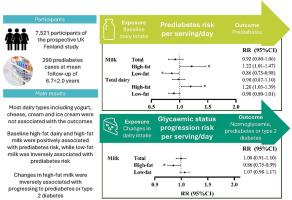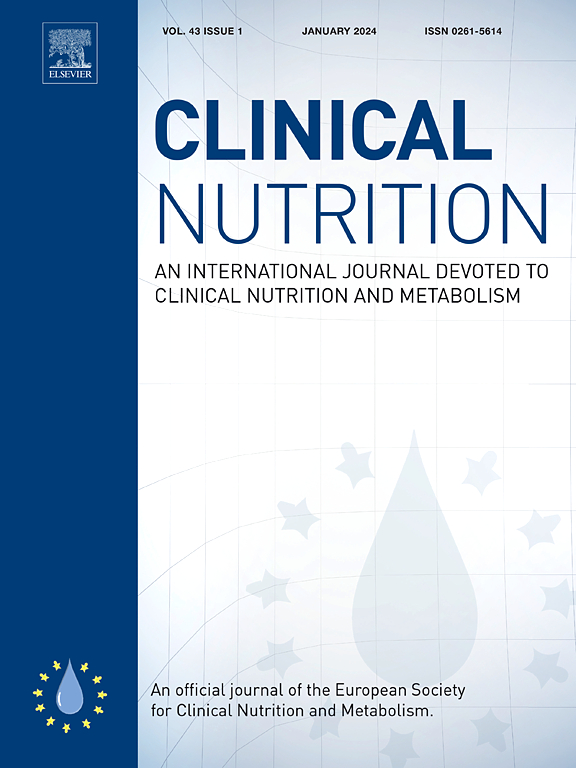芬兰研究中的乳制品消费与糖尿病前期和 2 型糖尿病风险
IF 6.6
2区 医学
Q1 NUTRITION & DIETETICS
引用次数: 0
摘要
背景&目的有限的观察证据表明,高脂乳制品摄入量越高,糖尿病前期风险越低,而低脂牛奶摄入量则与之相反。本研究旨在探讨乳制品基线摄入量及其变化、糖尿病前期风险和血糖状况之间的关系。方法:研究纳入了英国芬兰前瞻性研究的 7521 名参与者(平均年龄为 48.7 ± 2.0 岁,51.9% 为女性)。乳制品摄入量通过自我报告的食物频率问卷进行测量。结果在平均 6.7 ± 2.0 年的随访中,有 290 名参与者(4.3%)患上糖尿病前期。大多数乳制品与糖尿病前期风险无明显关联。高脂乳制品(RRservings/天,1.20,95%CI 1.03-1.39)和高脂牛奶(RRservings/天,1.22,1.01-1.47)的基线摄入量越高,糖尿病前期风险越高。相反,低脂牛奶则与较低的糖尿病前期风险有关(RRservings/day 0.86,0.75-0.98)。结论这项基于人群的研究表明,大多数乳制品与糖尿病前期风险或血糖状况的恶化无关。高脂乳制品、高脂牛奶与糖尿病前期风险呈正相关,而低脂牛奶与糖尿病前期风险呈反相关,这与之前的文献不一致,表明今后需要对环境、行为和生物因素进行研究,以解释现有证据。本文章由计算机程序翻译,如有差异,请以英文原文为准。

Dairy consumption and risk of prediabetes and type 2 diabetes in the Fenland study
Background & aims
Limited observational evidence suggests that a higher intake of high-fat dairy may be associated with lower prediabetes risk, while opposite associations have been observed for low-fat milk intake. This study aimed to examine associations between baseline and changes in dairy consumption, risk of prediabetes, and glycaemic status.
Methods
7521 participants from the prospective UK Fenland study were included (mean age 48.7 ± 2.0 years, 51.9 % female). Dairy intake was measured using self-reported food frequency questionnaires. Associations with prediabetes risk and glycaemic status were analysed using Poisson regression models adjusted for social demographics, health behaviours, family history of diabetes and food group intake.
Results
At a mean follow-up of 6.7 ± 2.0 years, 290 participants developed prediabetes (4.3 %). Most dairy products were not significantly associated with prediabetes risk. A higher baseline intake of high-fat dairy (RRservings/day 1.20, 95%CI 1.03–1.39) and high-fat milk (RRservings/day 1.22, 1.01–1.47) were associated with higher prediabetes risk. Conversely, low-fat milk was associated with lower prediabetes risk (RRservings/day 0.86, 0.75–0.98). In the analyses evaluating dietary changes over time, increases in high-fat milk were inversely associated with risk of progressing from normoglycaemia to prediabetes or type 2 diabetes (RRservings/day 0.86, 95%CI 0.75–0.99).
Conclusions
This population-based study showed that most dairy products are not associated with prediabetes risk or progression in glycaemic status. Positive associations of high-fat dairy, high-fat milk, and the inverse association of low-fat milk with prediabetes risk found were inconsistent with prior literature and suggestive of the need for future research on environmental, behavioural, and biological factors that explain the available evidence.
求助全文
通过发布文献求助,成功后即可免费获取论文全文。
去求助
来源期刊

Clinical nutrition
医学-营养学
CiteScore
14.10
自引率
6.30%
发文量
356
审稿时长
28 days
期刊介绍:
Clinical Nutrition, the official journal of ESPEN, The European Society for Clinical Nutrition and Metabolism, is an international journal providing essential scientific information on nutritional and metabolic care and the relationship between nutrition and disease both in the setting of basic science and clinical practice. Published bi-monthly, each issue combines original articles and reviews providing an invaluable reference for any specialist concerned with these fields.
 求助内容:
求助内容: 应助结果提醒方式:
应助结果提醒方式:


